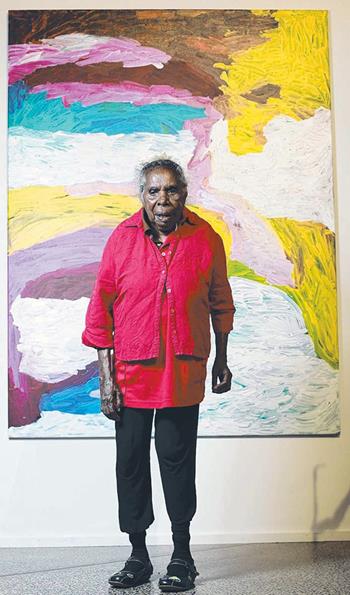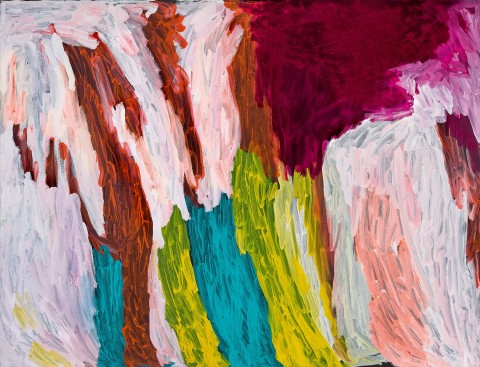DIBIRDIBI COUNTRY, 2011
MIRDIDINGKINGATHI JUWARNDA SALLY GABORI
synthetic polymer paint on linen
151.0 x 198.0 cm
bears inscription verso: artist’s name, title, medium and Mornington Island Arts and Crafts cat. SALLY GABORI/DIBIRDIBI COUNTRY/ SYNTHETIC POLYMER PAINT ON LINEN/736-L-SG-1011 and Alcaston Gallery cat. AK17462
Mornington Island Arts and Crafts, Queensland
Alcaston Gallery, Melbourne (bears gallery stamp verso)
Private collection, Melbourne
Danda nigijinda dulk, danda nigijinda malaa, danda ngad – This is my Land, this is my sea, this is who I am; A Survey Exhibition of Paintings by Sally Gabori: 2005 – 2012, Drill Hall Gallery, Australian National University, Canberra, 30 March – 5 May 2013
Knight, B., Maloon, T., and McPhee, J., Danda nigijinda dulk, danda nigijinda malaa, danda ngad – This is my Land, this is my sea, this is who I am. A Survey Exhibition of Paintings by Sally Gabori: 2005 – 2012, Drill Hall Gallery, Australian National University, Canberra, 2013, pl. 23, p. 46 (illus.)
Dibirdibi Country, 2011, synthetic polymer paint on linen, 151.0 x 198.0 cm, in the Collection of Anthony and Beverly Knight, Melbourne, illus. in Mirdidingkingathi Juwarnda Sally Gabori: dulka warngiid: Land of All, Queensland Art Gallery / Gallery of Modern Art, Brisbane, 2016, cat. 29, p. 108
Dibirdibi Country, 2011, synthetic polymer paint on linen, 198.0 x 455.0 cm, in the collection of Rockhampton Regional Art Gallery, Rockhampton, illus. in Mirdidingkingathi Juwarnda Sally Gabori: dulka warngiid: Land of All, Queensland Art Gallery / Gallery of Modern Art, Brisbane, 2016, cat. 26, pp. 98, 99
210811.jpg

Mirdidingkingathi Juwarnda Sally Gabori’s paintings are a tribute to the country on Bentinck Island, a small sparsely vegetated rise of land in the southern Gulf of Carpentaria where she grew up living off the natural abundance of the surrounding ocean and estuaries in the traditions of the Kaiadilt. In 1948, following a series of natural disasters, Gabori along with the other inhabitants of Bentinck Island, were forced to relocate to Gununa on nearby Mornington Island.
Almost sixty years later in 2005, Gabori, then in her early eighties, was invited to participate with other Kaiadilt in an art workshop at the Mornington Island Art Centre. After a few visits, it became clear that her early paintings – often crude abstract depictions of the myriad of fish found in the surrounding estuaries and sea – offered a unique and colourful expression of her personal and family stories spawned from the memories of her early years on Bentinck Island. Her artistic repertory consisted of six main subjects, all of them places on Bentinck Island included Mirdidingki (the place of her birth); Makarrki (her brother King Alfred’s country); Thundi (her father’s country); and Dibirdibi (her husband’s country). By painting each place over and over, she relived memories of the people and places she loved. As Cara Pinchbeck states, ‘Gabori’s works are a celebration of her homeland and illustrate a deep connection to country that has not diminished through separation. From her very earliest works, she has depicted aspects of her own beloved country as well as that of her brother, father and husband – including both geographical aspects of the landscape as well as the wildlife, specifically sea-life which is central to the landscape.’1
Dibirdibi Country, 2011 is a powerful recollection of the country of her husband, Kabarrarjingathi Bulthuku Pat Gabori, a rival of her brother King Alfred, and whose relationship with Gabori created intense friction within Kaiadilt society eventually resulting in the death of her brother.2 Dibirdibi is a subject and location painted more often by the artist than any other. Recalling the country of her husband and the Rock Cod Ancestor, this painting shows a large saltpan that covers part of her husband’s country close to the site where the liver of Dibirdibi, the Rock Cod Ancestor, was thrown into the sea, creating a permanent fresh water well. Covered with opaque layers of varied colours, combined with strong gestural mark-making, Gabori’s canvases are an expression of her love for her husband and the landscape of her country.
1. Pinchbeck, C., ‘Mirdidingkingathi Juwarnda Sally Gabori’ in unDisclosed, 2nd National Indigenous Art Triennial, National Gallery of Australia, Canberra, 2012, p. 64
2. McLean, B., ‘Dulka Warngiid; The Whole World’ in Mirdidingkingathi Juwarnda Sally Gabori Dulka Warngiid; Land of All, Queensland Art Gallery I Gallery of Modern Art, Brisbane, 2016 p. 16
CRISPIN GUTTERIDGE
